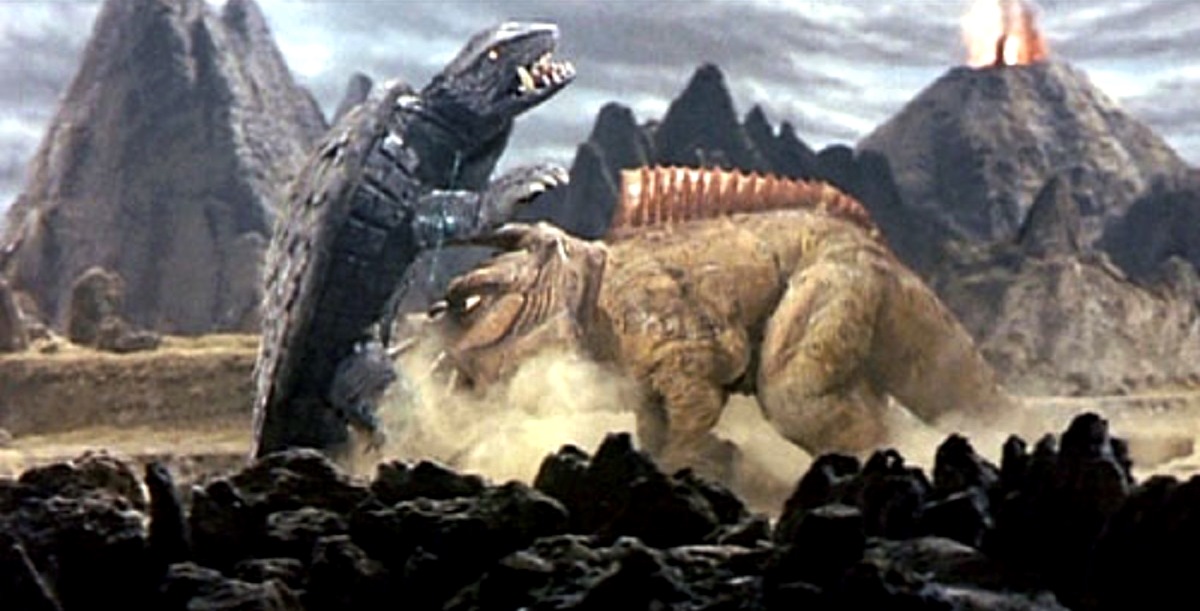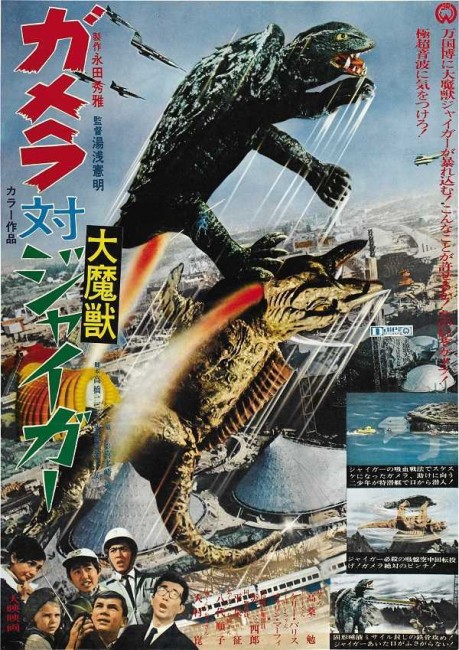aka Gamera Vs Monster X; Monsters Invade Expo 70
(Gamera Tai Daimaju Jaiga)
Japan. 1970.
Crew
Director – Noriaki Yuasa, Screenplay – Nisan Takahashi, Producer – Hidemasa Nagata, Photography – Akira Kitazaki, Music – Shunsuke Kikuchi, Special Effects – Kazufumi Fujii, Special Effects Photography – Yuzo Kaneko, Production Design – Akira Inoue. Production Company – Daiei.
Cast
Tsutomu Takakuwa (Hiroshi Isako), Kelly Varis (Tommy Williams), Katherine Murphy (Susan Williams), Kon Omura (Mr Isako), Akira Natsuki (Dr Suzuki)
Plot
A statue from Wester Island is to be brought to Japan as part of Expo 70. Gamera appears and tries to stop the statue being airlifted off the island but is attacked and downed by a monster that appears from out of the volcano. The monster Jiger, or Monster X as it is named by the scientists, follows the statue to Osaka and wreaks a trail of destruction with its deadly spear projectiles and the raybeam horn on the top of its head. Gamera follows but is near-fatally downed after being jabbed by Jiger’s tail. Two kids, Hiroshi and Tommy, realise that Gamera has been injected with Jiger larvae. They take the miniature submersible built by Hiroshi’s father for the Expo and use it to enter Gamera’s body to remove the larvae and restore Gamera to life.
Gamera vs Jiger was the fifth and second-to-last of the classic sequels to Gammera the Invincible (1965). Gammera was an effort by the Japanese company Daiei to copy the success enjoyed by Toho’s Godzilla films. Gammera was an okay effort but the sequels – Gamera vs Barugon/War of the Monsters (1966), Gamera vs Gyaos/Return of the Giant Monsters (1967), Destroy All Planets (1968), Attack of the Monsters/Gamera vs Guiron (1969) and subsequent to this Gamera vs Zigra (1971) and the later compilation film Gamera: Super Monster (1980) – were down around the level of Jun Fukuda’s Godzilla films of the 1970s, all cheaply made and increasingly intended for children. The series however was successfully revived in the 1990s – see below.
The entire pitch of Gamera vs Jiger has been to make the film in and around Expo 70, the 1970 world’s fair (which highlights industry and culture and has been held annually in a different city of the world since 1756). This was the first time that Japan had been chosen to host a world’s fair. Clearly, Japan regarded this as a major cultural prestige and saw fit to conceive an entire monster movie around it – the film was even sold as Monsters Invade Expo 70 in some places.
There is the usual loopy plotting of these films – the talk of Wester Island (an obvious play on Easter Island and the moai (stone heads) there), as well as connection made to the lost continent of Mu, a now discredited 19th Century notion of a sunken continent in the Pacific Ocean, which takes the film into the arena of Erich von Daniken and Ancient Astronauts – see Chariots of the Gods (1970) – that was gaining much popularity around the time. The same fascinations and reference to Mu also turned up in Toho’s Godzilla vs Megalon (1973) soon after.

One of the strangest aspects of the film is where the filmmakers have taken clear inspiration from the hit US film Fantastic Voyage (1966) about a submarine crew being miniaturised and undertaking a journey inside the human body to conduct a medical operation. Here the film diverts off into a substantial subplot that has been directly copied from Fantastic Voyage where two kids enter Gamera’s body in a submersible (not miniaturised) to remove an infection caused by Jiger’s larvae. This is a bizarrely unconvincing sequence where we essentially get Fantastic Voyage conducted on the cheap – there are almost no exteriors or model shots of the submarine inside Gamera’s body, mostly just a sequence set in a cave filled with inflated plastic bags where the kids fight off a rubbery embryo Jiger.
The film is, as most of the Gamera films of this period were, hampered by crappy special effects. Gamera looks rubbery and immobile. There are some childish fights between it and Jiger – they batting rocks back and forth; Gamera picking Jiger up, flying up into the air and dive-bombing him into the ground; Jiger firing its needles and downing Gamera. Clearly coming up with some kind of original monster was proving a strain and Jiger looks like a stubby triceratops. Not to mention that it comes with some decidedly strange powers – aside from being able to create sonic blasts, fire an arsenal of needles at enemies and an extendable syringe tail that injects larvae, it can discharge its needles in a square pattern across wide areas and then fire a ray from the glowing horn on the top of its head that disintegrates everything inside the field.
As kaiju eiga of this era goes, Gamera vs Jiger makes for one of the weaker. One of the biggest drawbacks dramatically is that Gamera is downed by Jiger and left in a near-death state for much of the middle of the film – a rather absurd condition that involves it lying partially in the water with its head and one paw painted white for some length of time. The climactic battle between the two monsters is completely ridiculous – the thoroughly absurd image of Gamera picking up two telephone poles and jamming them into its ears to protect against Jiger’s sonic rays; not to mention the children standing on the sideline cheering Gamera on and even shouting out combat directions to it.
The other Gamera films are:– Gammera the Invincible (1965), Gamera vs Barugon/War of the Monsters (1966), Gamera vs Gyaos/Return of the Giant Monsters (1967), Destroy All Planets (1968), Attack of the Monsters/Gamera vs Guiron (1969), Gamera vs Zigra (1971) and Gamera: Super Monster (1980). The series was revived in the 1990s with Gamera, The Guardian of the Universe (1995), Gamera 2: Assault of Legion (1996), Gamera 3: Revenge of Iris (1999) and Gamera the Brave (2006).
Trailer here


